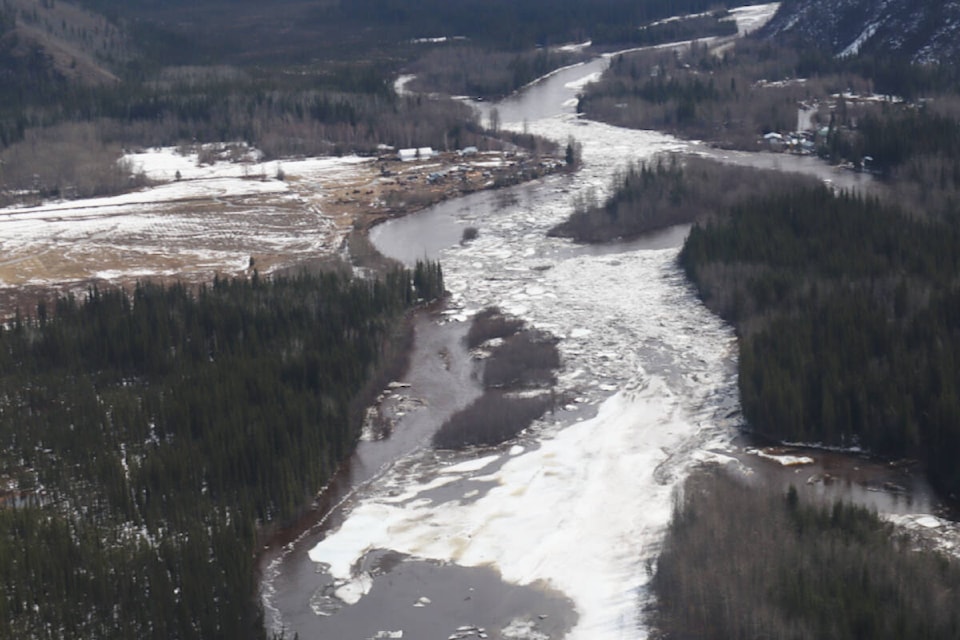Close attention is being paid to the snowpack in the Northern Yukon and preparations for possible floods when all that snow melts.
The territorial government’s April 1 snow survey noted the record-setting snowpack in the Porcupine River basin, which includes the village of Old Crow, at 166 per cent of the historical median.
The Peel River Basin is also blanketed in well-above-average snowpack at 140 per cent of the historical median. The lower Yukon River basin is also at 124 per cent of the median.
In contrast, the Southern and Central Yukon are sitting at average and slightly below-average snowpacks.
A briefing from the territorial government on April 10 suggests that the highest flood risks this spring are expected in Old Crow, the Klondike Valley and the Dempster Highway. Flood response efforts are also focused on these areas.
Government hydrologist Anthony Bier elaborated on the snowpack situation, stating that the southern and central regions of the territory have not experienced a year this dry since 2019. He said snowpack conditions in the Dawson City area are similar to last year.
Bier described a hazard posed in the Klondike Valley due to an ice jam caused by a “dynamic freeze-up” at the start of the winter. The result is ice floes pushed downstream, jamming up at the North Klondike Highway bridge near the entrance to Dawson, and still frozen there.
“So, for ice-jam flooding, we assess the flood risk potential separately from freshet flooding. We have high (flood risk) in the Klondike Valley, mostly owing to that dynamic freeze up that I spoke of earlier, as well as above average snowpack,” he said.
Bier noted that while the risk for the Klondike Valley is high, the risk for Dawson itself is low.
Because of the location of the ice jam, Bier said that the vicinity of the highway bridge and Prospector Road is more threatened with flooding this year, while the Rock Creek and Henderson Corner areas that took the brunt of the flooding in 2023 are less likely to be affected as there are no ice jams there at this time.
Bier said that the Old Crow area is experiencing close to normal ice thickness, but sudden sustained warming coupled with the snowpack in the area could cause problems. There has not been any notable warming yet, and the forecast is close to average for the next 14 days. Bier added that the flood risk for the area is high due to the record snowpack.
Rapid warming could also lead to a “mechanical or dynamic breakup” and more risk of ice jamming.
He noted that most rivers around the territory are slightly above their normal range of flows for this time of year, a trend he attributed to more groundwater and shorter winters.
In all cases in the Northern Yukon, Bier said the ideal scenario is a steady melt with no rain.
“The timing and progression of snow melt and precipitation are really the critical drivers regardless of the snowpack levels. And, you know, I should say that even if you have a low flood risk, that doesn’t mean there’s no risk of flooding, it just means there’s a low or average risk. So it can still happen, it’s just very unlikely,” he said.
Greg Blackjack, the director of the territory’s emergency measures organization, said flood protection equipment has been deployed to strategic locations across the territory. Whether at those strategic locations or stored in Whitehorse, Blackjack noted there is a surplus of equipment left over from last year, and arrangements have been made with suppliers should those stocks need to be replenished.
Blackjack added that there was a variety of training, including tabletop exercises, with municipalities during the offseason.
Yukon Community Services Minister Richard Mostyn noted that the territory’s 2024/25 budget funds work in support of hazard identification, risk assessment, climate-resilient infrastructure and forecasting capabilities.
Mostyn pledged improvements based on lessons learned during the recovery from last year’s flooding in the Klondike Valley. He also spoke of a new permanent Yukon Disaster Financial Assistance Program, which will be in place in advance to cover uninsurable losses.
As with other emergency briefings, the government officials stressed the importance of personal preparedness, offering suggestions such as building a 72-hour kit of essentials.
The briefing was also used to discuss the outlook for the coming wildfire season. Wildland Fire communications officer Haley Ritchie informed the briefing that crews are back at their bases and well-staffed for the coming season.
She also noted the lack of holdover fires that burned through the winter in the Yukon; other jurisdictions have reported them in the wake of a very smoky summer in 2023.
Ritchie noted that prescribed burns are being planned near Watson Lake, Mayo, Carmacks and Whitehorse. They will be carried out if conditions allow.
Property owners were also reminded to take steps to manage flammable materials like tree needles, cones and firewood piles on their properties in advance of this summer’s hot, dry days.
Contact Jim Elliot at jim.elliot@yukon-news.com.
